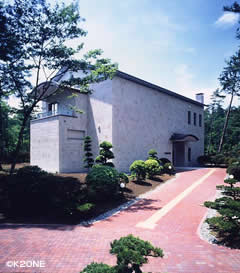Guide to Yamanakako Forest Park of Literature
Mishima Yukio Literary museum(Mishima Yukio Bungaku-kan)

As the center of Mishima Literature, it houses: hand -written manuscripts, notes on story
writing & interviews, letters, paintings, portrait photographs, published books, research notes/materials, translated works, first prints, and notes/materials on films & plays.
On the 2nd floor, we have a reading room which is open to public for browsing books,
magazines etc. and a facility for reference viewing and photocopying service.
◎Profile Yukio Mishima:(1925-1970)
Born “Kimitake Hiraoka” on 14th January 1925 in Tokyo. Began writing novels from the early
teens when his unequivocal talent as a writer became evident. Educated at Gakusyuin
Boy's Senior High School before graduating University of Tokyo (majored in law). While at
university, "The forest in Full Bloom" (1944) was published.
Soon after leaving his job at the Ministry of Finance, the publication of "Confessions of a Mask"
(1948) followed which brought him instant fame, rending him the darling
of the literary world.As the leading figure of modern literature, he continued to write in various
literary forms, including novels, plays, reviews etc. until he committed a suicide in 1970.
Most famous works include: "Confessions of a Mask" (1949),"Sound of the
Waves" (1954),"Temple of the Golden Pavilion"(1956),"Modern Noh Plays"
(1956),"Madame de Sade" (1965),"Sun and Steel"(1967),"The Sea of Fertility"(1964-1970).
Tokutomi Soho Memorial Museum(Tokutomi Soho-kan)

The museum displays Soho's original manuscripts, scrolls, letters, correspondence, portrait-
photographs, publications, research books and magazines featuring Soho.
Besides
the
materials
anddocuments related to Soho, the museum houses and displays the works of and about other
leading figures from politics, business literature, art andeligion of the period,
including:
Kaishu Katsu, Shounan Yokoi, Kisui Tokutomi (Soho's father),Roka Tokutomi (Soho's young
brother), Hirofumi Ito, Masayoshi Matsukata, Ryushi Kawabata,Akio Yosano,
Kosuke Tomeoka,
Kiyoshi Shiga and Kozui Otani.
◎Profile Soho Tokutomi:(1863-1957)
Born “Iichiro Tokutomi” on 25th January 1863 in Kumamoto prefecture, Japan. Soho is the
elder brother of the novelist Roka Tokutomi (birth name: Kenjiro Tokutomi).
Soho learnt the
chinese
classics at a private tutoring school from an early age and later on studied at Doshisha-
University. While he was in his twenties, he founded the publishing companies
Minyusha and Kokumin Shinbun-Sha and was one of the leading figures in journalism during the mid-Meiji
period. Between 1932 and 1945, Soho spent every summer in his second house
in Yamanakako,
where he continued to write. “Asahigaoka”, a district in Yamanakako village, and “Houko-sai”,
a summer festival in Yamanakako were both named by Soho.
Being a man of conviction and
perseverance, at the age of ninety Soho completed his life-long project over 35years "A History
of Early Modern Japan"which was pubulished in total of hundred
volumes.
Opening hours
10:00 am-4:30 pm (Enter before 4:00pm)
Closed
Every Monday (or Tuesday if Monday is a national holiday)
Dec.29-Jan.3
On material inspection day (irregular)
※Open during the period Apr.28-May 6 including Monday
Admission fee
| Individual | Group | Disabled | |
|---|---|---|---|
| Adult | 500yen | 450yen | 250yen |
| High School & College/ University students | 300yen | 250yen | 150yen |
| Elementary & Junior High School students | 100yen | 50yen | 50yen |
※The admission ticket is valid for both Mishima Yukio Literary Museum and Tokutomi Soho Memorial Museum.
※Any group consisting of more than 10 persons is subject to a group discount.
※Disability certificate/booklet is required to be eligible for a disabled discount.
One accompanying person is also eligible for a discount.
※Relevant IDs are required to be eligible for a student discount.
※Discounts cannot be applied unless relevant certificates/IDs are presented.
※Free of charge for children under school age.
Please pay attention to the followings
●Do not copy the materials, take pictures, eat or drink in the exhibition room.
●Do not use the mobile phones in the exhibition room.
●Do not disturb other visitors.
●Do not touch the articles on display.
●No smoking in the museum.
●No pets are allowed in the museum, except for such service dogs as seeing-eye-dogs, etc.
●The admission ticket is valid for one person per piece, one time and the appointed day.
●Do not detach the stub from the ticket as this will invalidate the ticket
●The admission ticket may not be re-issued in any case.
Directions
◎Access by train:
●From Shinjuku station―(JR Chuo Line)―Otsuki station―(Fujikyukou Line)―Mt.fuji station―(local bus)
―Yamanakako★
Approx. 3hrs
●From Nagoya station―(JR Tokaido Shinkansen-Kodama)―Mishima station―(local bus)―
Gotemba station―(local bus)
―Yamanakako★
Approx. 3hrs 20min
★The nearest bus stop to the museum: “Bungaku-no-Mori Koen mae” 5mins.walk to the museum
◎Access by highway bus:
●From Shinjuku bus terminal via Chuo-Expressway to Yamanakako bus terminal
Approx. 2hrs 30min (Then 15mins. walk from Yamanakako bus terminal)
◎Access by car:
●FromTokyo/Nagoya- after Chuo/Tomei Expressways take Higashi Fuji-goko Expressway
towards Yamanakako.
Exit at Yamanakako I.C. and take Route138 towards the direction of
“Yamanakako/Gotemba.”
The museum complex is situated after 4km from the Yamanakako
in the Asashigaoka district of Yamanakako village.
The turning to Forest Park of Literature
is sign-posted with a white sign Route138.
Contact
Mishima Yukio Literary Museum (Mishima Yukio Bungaku-kan)
506-296 Hirano,Yamanakako-mura,Minamitsuru-gun,Yamanashi-Ken,401-0502
Phone: 0555-20-2655 Fax: 0555-20-2656
E-mail
info@mishimayukio.jp
Tokutomi Soho Memorial Museum (Tokutomi Soho-kan)
506-296 Hirano,Yamanakako-mura,Minamitsuru-gun,Yamanashi-Ken,401-0502
Phone: 0555-20-2633 Fax: 0555-20-2634